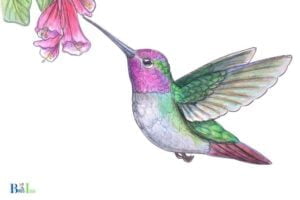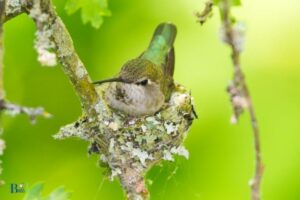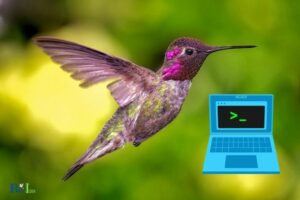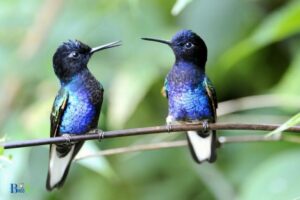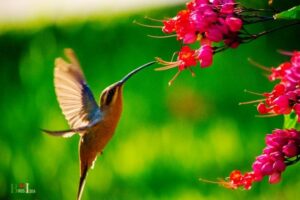How to Hand Feed Hummingbirds? 7 Steps!
To hand feed hummingbirds, you need to create a safe environment, use the right feeder or nectar, and patiently gain the birds’ trust by staying still and quiet while holding the feeder.
Hand feeding hummingbirds can be a rewarding experience, but it requires patience and dedication.
By following the right steps and creating a comfortable environment for the birds, you can successfully attract them to feed straight from your hand.
Once you’ve set up your feeding station and prepared the nectar mix, position yourself near the feeder, holding it in your hand. It’s essential to remain patient, still, and quiet to avoid scaring the hummingbirds away.
Over time, as the birds become accustomed to your presence, they will feel more comfortable approaching you and eventually feed right from your hand.
This unique experience allows you to appreciate the beauty and grace of these tiny birds up close.
7 Steps for Hand Feed Hummingbirds
| Step | Description |
|---|---|
| 1 | Prepare the nectar |
| 2 | Choose the right location |
| 3 | Get comfortable and be patient |
| 4 | Use a brightly colored object |
| 5 | Slowly move the nectar closer to the hummingbird |
| 6 | Hold still and let the hummingbird come to you |
| 7 | Maintain a consistent feeding schedule |
Key Takeaway
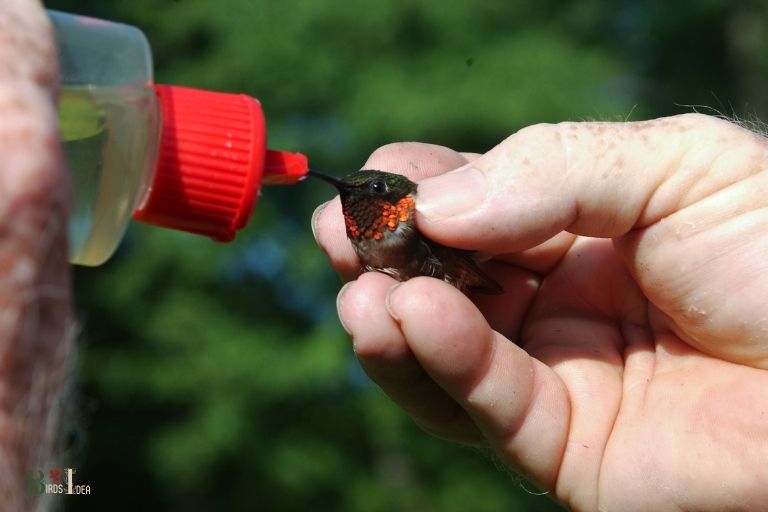
Five Facts About Hand Feeding Hummingbirds
Understanding Hummingbirds And Their Feeding Habits
Hummingbirds are fascinating creatures that are cherished by bird-watchers around the world. These tiny birds require a high metabolic rate, which means they have to feed frequently to get enough energy to fly.
Here’s what you need to know before you start hand feeding hummingbirds.
Characteristics And Traits Of Hummingbirds
Hummingbirds have several unique features that make them different from other birds. Understanding the characteristics of hummingbirds will help you to set up the perfect feeding station for them.
Some of their main traits include:
- Small size: Most hummingbirds are between 3 and 5 inches long, making them one of the smallest bird species in the world.
- High metabolism: Hummingbirds require a huge amount of energy to stay airborne.
- Great eyesight: Hummingbirds have excellent eyesight and can see colors that humans cannot.
- Wings: Hummingbirds’ wings can beat up to 80 times per second in some species.
- Feeding habits: Their long beaks and tongues are adapted to extract nectar from flowers.
Types Of Feeders Available
There are several types of hummingbird feeders available in the market, and the choice you make depends on your needs.
When selecting a feeder, ensure that it is easy to clean, and the nectar is transparent to prevent contamination.
Here are the most common types of hummingbird feeders on the market:
- Glass feeders: These are the most popular type of hummingbird feeders because they are easy to clean, and the glass does not hold any odors or stains.
- Plastic feeders: These are more durable than glass feeders but require more cleaning to prevent staining.
- Bottle feeders: These are convenient and easy to use. They have a feeding tube attached to a bottle filled with nectar.
Importance Of Feeding Hummingbirds
Hummingbirds are essential pollinators in different ecosystems, and therefore, their viability is a critical issue.
Hand feeding hummingbirds is an excellent way to support their population as it ensures that they have a readily available source of nectar. Hummingbirds also rely on a diverse range of nectar sources.
Therefore, you can supplement their natural food sources by providing a feeding station for them. Hummingbirds are fascinating creatures that require frequent feeding to stay healthy and active.
When hand feeding hummingbirds, it is crucial to understand their unique traits and feeding habits to create the perfect feeding station for them.
By providing a readily available source of nectar, you will be aiding their survival and contributing to their population growth.
Preparing To Hand Feed Hummingbirds
Hand feeding hummingbirds is a thrilling and rewarding experience that can provide an excellent opportunity to enjoy these tiny, quick-moving birds up close.
However, before starting to hand feed hummingbirds, it’s essential to be adequately prepared. Here are the key things to keep in mind when getting ready for the experience:
Choosing The Right Location:
Hummingbirds are often found in gardens, natural feeding locations, and places with an abundance of flowers.
When hand feeding hummingbirds, it’s important to choose a calm and safe location, like a private backyard or a secluded area in a park where hummingbirds are frequently seen.
Necessary Equipment And Supplies:
To hand feed hummingbirds, you will need some essential supplies and tools.
These include:
- A hummingbird feeder – purchase a hummingbird feeder that is red in color (a color that attracts them) and allows them to perch while sipping nectar. When it comes to feeder capacity, choose one that can hold enough nectar for several feeding sessions.
- A solution of nectar – fill the feeder with a homemade solution of four parts water and one part white granulated sugar, boiled and cooled. Natural feeding locations, and places with an abundance of flowers. When hand feeding hummingbirds, it’s important to choose a calm and safe location, like a private backyard or a secluded area in a park where hummingbirds are frequently seen.
- Clean water – clean water is essential to fill the nectar feeder during the feeding session.
- Perch – hummingbirds love to perch on small sticks, twigs, and other similar items. Providing them with a perch makes the feeding session more comfortable for them and can help them relax.
- Camera – taking photos of hummingbirds while hand feeding can be a once in a lifetime opportunity. Be sure to have your camera or phone handy!
Maintaining Cleanliness And Hygiene:
Keeping things clean and hygienic is essential when hand feeding hummingbirds. Hummingbirds are sensitive to dirt and germs, so maintaining a clean feeding environment is imperative.
Here are some things to keep in mind during the feeding session:
- Wash your hands thoroughly with soap before and after feeding the hummingbirds.
- The nectar feeder should be cleaned thoroughly before and after each feeding session, disassembled and soaked in hot soapy water for at least thirty minutes. Rinse it thoroughly with clean water and refill it with a fresh solution of nectar before each session.
- Keep the feeding area clean and tidy, and remove any spilled nectar, dirt, or debris.
- The feeding session should be brief, lasting no more than 15-20 minutes, to prevent the hummingbirds from overfeeding or becoming reliant on hand feeding.
By following these simple guidelines, you’ll be well on your way to a successful and enjoyable experience of hand feeding hummingbirds.
With patience, care, and proper preparation, you’ll create a fascinating connection with these beautiful birds while learning more about their unique lives and habits.
Teaching Hummingbirds To Feed From Your Hand
Hand feeding hummingbirds can be an incredibly rewarding experience, as it allows you to observe these tiny creatures up close.
Teaching a hummingbird to feed from your hand requires patience, persistence and understanding of their feeding behavior.
In this guide, we will discuss the key steps to follow in order to successfully hand feed hummingbirds.
Feeder Placement And Arrangement
Before beginning to hand feed hummingbirds, it is important to have hummingbird feeders set up in your garden or backyard that are visible from a comfortable seating position.
Place the feeder at a height of at least 6 feet and away from any other feeding stations to avoid competition.
When arranging your feeder, ensure that it has brightly colored and attractive flowers to help attract hummingbirds. It is also recommended to hang multiple feeders in different locations, making it easier for the hummingbirds to locate them.
Offering Nectar From Your Hand
Once your hummingbird feeders are set up, it is time to offer nectar from your hand. To do this, wear bright colors and sit quietly in front of the feeder.
Hold a small feeder near your hand filled with nectar and wait for the hummingbirds to begin feeding.As the hummingbirds become accustomed to feeding from the feeder, move it slowly closer to your hand.
Once the hummingbirds are comfortable feeding from the feeder at a close distance, hold your hand out with a small amount of nectar on your palm.
Patience And Persistence In Training Hummingbirds
Training hummingbirds to feed from your hand requires patience and persistence.
Some hummingbirds might be curious and receptive to feeding from your hand after only a few attempts, while others may take days or even weeks to become comfortable.
If the hummingbird appears hesitant or uncomfortable approaching your hand, try holding the nectar feeder closer to your hand to entice them.
It is essential to move slowly and avoid any sudden movements that could scare the hummingbirds away.
Always remember to maintain a respectful distance from hummingbirds and avoid interacting with them for extended periods, as it can be stressful for the birds.
Once you have successfully trained hummingbirds to feed from your hand, the experience can be truly breathtaking and provide a rewarding sense of connection to these incredible creatures.
Tips For Successful Hand-Feeding
Understanding The Appropriate Feeding Time
Hummingbirds are known for their preferred feeding time- early in the morning or late in the afternoon when the sun is not at its peak. It is essential to understand the appropriate feeding time to attract hummingbirds for hand-feeding.
Here are essential things to note for the appropriate feeding time:
- Feeding should be done early in the morning or late in the feeding when hummingbirds start their feeding rounds
- Avoid feeding at noon when the sun is at its peak
- Ensure that the feeding schedule is consistent to maintain hummingbird’s feeding pattern
Recognizing And Addressing Aggression
When introducing hand-feeding to hummingbirds, you need to be aware of hummingbirds’ aggression. They can be territorial and can display aggressive behavior when defending their food sources.
Here are some tips to help address aggression when hand-feeding hummingbirds:
- Monitor hummingbirds’ behavior during feeding to identify aggressive behavior
- Position yourself in a way that keeps hummingbirds calm when feeding
- Always wear bright colors to avoid attack by other birds, mistaking you for a predator
Assessing Hummingbird Health And Behavior
Before hand-feeding hummingbirds, it is essential to assess their health and behavior to ensure their safety.
Hand-feeding hummingbirds that are unwell can lead to further complications, and it can be dangerous for both hummingbirds and humans involved.
Here is what you need to note:
- Observe their feathers and body- if they look disheveled or fluffed, it could be a sign of sickness
- Check their behavior closely to identify any signs of stress or sickness
Always keep cleaning your hands before and after hand-feeding hummingbirds to prevent the spread of diseases. With these tips, you can now successfully hand-feed hummingbirds in your area with ease.
FAQ About Hand Feeding Hummingbirds
How Can I Attract Hummingbirds To My Hand?
Is It Safe To Hand Feed Hummingbirds?
What Kind Of Food Can I Give To Hummingbirds?
Should I Wear Anything Special When Hand Feeding Hummingbirds?
How Long Does It Take For Hummingbirds To Get Used To Hand Feeding?
Conclusion
As you can see, hand feeding hummingbirds is an exceptional experience that requires patience, persistence, and a gentle touch. By following the tips and guidelines outlined in this tutorial, you can establish trust with these winged beauties and have a front-row seat to their majestic lifestyle.
Remember to keep your nectar mixture fresh and free of harmful additives, choose a location with minimal distractions or threats, and always be respectful of the hummingbirds’ boundaries.
With a little effort and a lot of love, you can create a unique bond with these tiny creatures and be rewarded with some of the most intimate wildlife encounters imaginable. So don’t hesitate to try your hand at hand feeding hummingbirds and savor the magic that awaits you.

